Ron Kaulbach has steered his motorboat in the Ottawa River past Canada’s oldest nuclear research facility in Chalk River many times.
“They don’t like you taking photos of the property,” says Kaulbach, a longtime nearby resident. “Even in a motorboat.”
There are photo sensitive areas on the site, said a spokesperson for Chalk River Laboratories (CRL), but there’s no stopping photographers on the river.
The spokesperson referred to a “relic from the past,” a widely circulated photo from 1945 of a large white placard on the shoreline. The sign said “picture taking prohibited” against a backdrop of a water tower, a stack and several buildings on the site.
It was that year that Canada’s first nuclear reactor began operating at Chalk River, about 160 kilometres northwest of Ottawa. Since 1944, the facility has served as Canada’s major nuclear science hub. Researchers at CRL have studied reactors, nuclear energy and weaponry and produced medical isotopes for patients around the world.
The facility was joined in 1962 by the first power-generating CANDU reactor in Canada at Rolphton, about 30 kilometres upstream. It was closed in 1987.
Now that CRL’s reactors at Chalk River have gone dark for the last time, the focus has shifted to decommissioning and revitalizing the grounds and getting permission from federal nuclear and environmental regulatory authorities to build a waste burial site that would operate for at least 50 years.
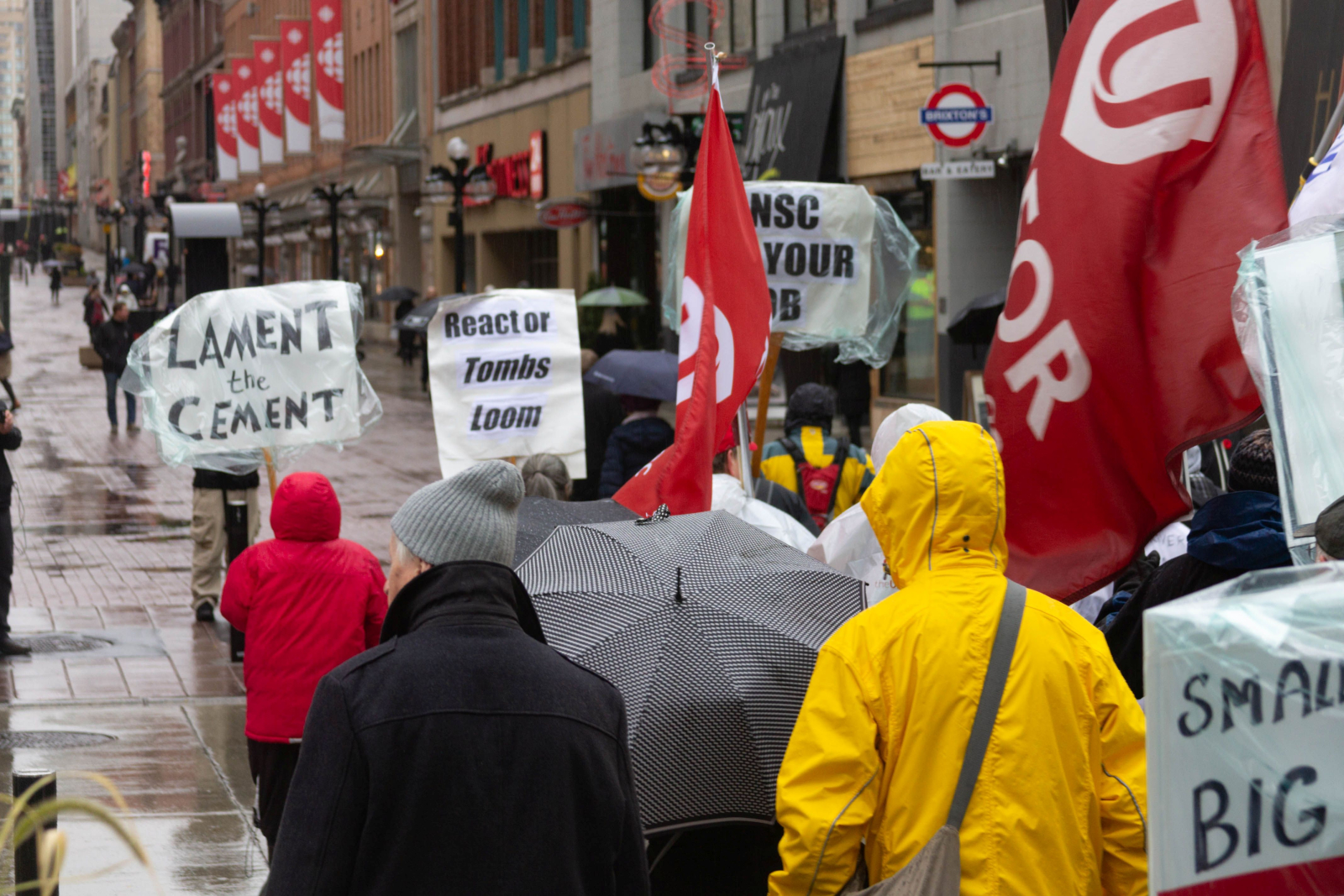
Environmentalists and concerned citizens groups in Ottawa protest a proposed permanent nuclear waste dump on Nov. 6, 2018. Photo by Lauren Hicks
“It is crucial to protect the drinking water source of over two million people,” says Ottawa Riverkeeper, a full-time, non-profit organization that serves as a public advocate for the watershed and is a key intervenor in the environmental assessment of the waste proposal.
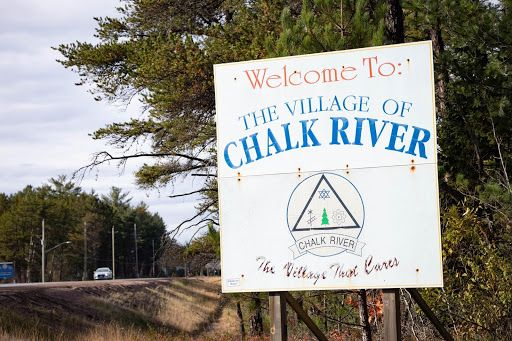
The Chalk River site resembles an old university campus. It’s cut out of a thick and isolating forest spanning about 10,000 acres, with neatly trimmed patches of grass, and a regimented mix of large brick and smaller white structures.
The facilities owned by Canadian Nuclear Laboratories (CNL) are about seven kilometres from the gate at the border of Chalk River, a community of fewer than 1,100 residents, some of whom work at the lab which has about 2,800 employees.
Signs on a chain link fence and tree trunks along the perimeter indicate the grounds are protected by armed officers. Surveillance cameras cast a visual blanket over the road to the security clearance booth and over much of the site.
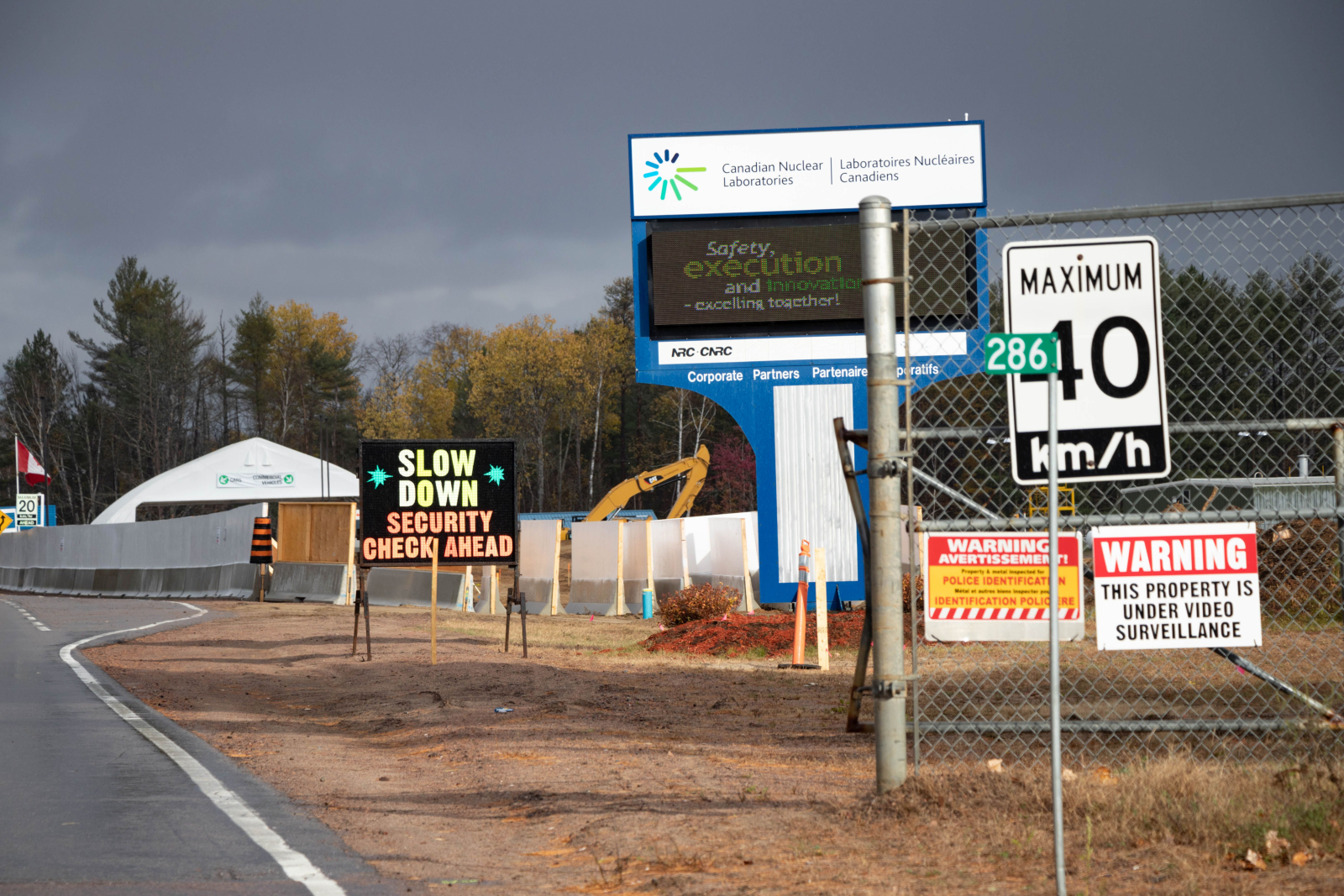
Chalk River Laboratories has for decades faced questions over the way it deals with its radioactive waste. Environmentalists have decried the facility for discharging waste into the river and for leaks. CNL says its methods for treating waste are sound and the regular liquid effluent discharges into the river have no significant public health or environmental impact on drinking water. It reports a steady evolution of environmental stewardship.
Fresh concern erupted after CNL announced detailed plans to build a nuclear disposal facility to permanently house one million cubic metres of radioactive waste -- about 400 Olympic-sized swimming pools worth.
In May 2016, the Canadian Nuclear Safety Commission launched the environmental assessment process for the disposal project with an initial call for public comment.
Environmentalists and concerned citizens questioned how nuclear waste can remain securely contained for hundreds of years, and how it might endanger water quality if any leaks.

The waste has accumulated over decades of Chalk River’s operations. It includes low-level material, such as equipment from operations that has been irradiated and buildings that housed the reactors, and intermediate-level waste, such as filters used to purify reactor water systems and reactor core components. The irradiated material sits anywhere from a few metres to a few kilometres from the Ottawa River.
While the facility is a source of alarm to some, it is a source of pride for many local community members, says Douglas Cochrane, a resident of the nearby town of Deep River. Noting that radioisotopes for cancer treatment and research were produced there for years, Cochrane said, “I feel like that’s something you should be proud of and for me, it’s something I’m proud of.”
“With some of my own family, we’ve had our fair share of tough battles with cancer and radiation has been helpful and life-saving a lot of times,” Cochrane said.
Canadian Nuclear Laboratories (CNL) promotes itself as a global leader in developing applications for nuclear technology through research, engineering and waste management services.
It is a subsidiary of Atomic Energy of Canada Limited (AECL), a federal Crown corporation, and operated by the Canadian National Energy Alliance, a private consortium. Its operations are licensed by the Canadian Nuclear Safety Commission, the nation’s nuclear regulator.
What do water quality tests near Chalk River say?
Some nearby residents and environmental groups have argued that, while CNL says it is committed to safeguarding the health of the Ottawa River during the decommissioning process, questions remain about the lab’s ability to safely dispose of radioactive waste.
The lab’s history is peppered with minor leaks and malfunctions – and a few major ones. Critics worry that the organization’s confidence in the safety of decommissioning efforts is misplaced.
For instance, critics claim the lab is not fully transparent about its water quality testing methods and has not properly informed the public on plans for permanent storage and disposal of the radioactive material.
Ottawa resident Ole Hendrickson is a member of the Concerned Citizens of Renfrew County and Area, an Ottawa-based environmental activist group whose volunteers have worked for the clean-up and prevention of radioactive pollution from the nuclear industry in the Ottawa Valley for more than 40 years. He’s also a member of CRL’s environmental stewardship council, which convenes company officials, community representatives and other stakeholders several times a year to discuss updates from the lab.

A protester speaks during a Nov. 6, 2018 rally at Parliament Hill against a permanent nuclear waste proposal proposed by Canadian Nuclear Laboratories near the shores of the Ottawa River. Photo by Lauren Hicks
Hendrickson said in an interview that CNL is stingy about providing environmental monitoring data, and that many of the documents with information on testing he has received through access to information requests include significant redactions.
Yet authorities in nearby towns appear unconcerned.
Brenda Royce works at the Ontario Clean Water Agency in Petawawa, about 20 kilometres downstream from Chalk River. It is a provincial Crown agency that the town contracts to do its water quality testing and water system maintenance.
In addition, Royce said her office collects a water sample from the Ottawa River at Petawawa every day for CNL to conduct its own tests. But the office does not get the results of the tests back from the private lab.
Every year, Petawawa’s water agency publishes its own report on the town’s drinking water quality and treatment system. The agency’s report includes testing for many chemicals — including uranium — but not for the two main radionuclides that might be discharged from Chalk River Laboratories operations: tritium and strontium. “It’s just what we do,” Royce said, adding she has never been curious to see results on radioactive waste in the water system.
Petawawa’s director of public works said he has never met with Chalk River officials over potential water quality hazards in the area. “I’m sure as a good corporate citizen that they would make calls to surrounding municipalities that would be affected, were there any issues,” said David Unrau, who has worked for the town since 2012.

In 2012, the site’s former Crown operator contracted Université Laval to conduct independent environmental tests of the water, air and vegetation around Chalk River Laboratories and the municipalities of Petawawa and Pembroke, just south of the facility, which would be most directly affected by any potential nuclear contamination in the river. The results for 2012, 2013 and 2015 have been posted on the nuclear industry regulator’s website, and results for 2018 will be published. As of yet, no tests returned results that were expected to cause adverse health effects.
Canada’s Nuclear Safety Commission did not provide data or respond to technical questions before publication and was not available for an interview.
Test results from 2015 show levels of radioactive isotopes present in the river, such as strontium and tritium, were far below the threshold that would affect human health.
Health Canada guidelines state the maximum concentrations of strontium and tritium in drinking water are seven milligrams per litre, and 7,000 becquerels per litre, respectively.
Independent tests for strontium and tritium in the Ottawa River at Rolphton, Petawawa, and Pembroke were conducted specifically for this story. The results found strontium and tritium were not at dangerous levels in the water, as of November 2018. All indicated waste levels in the river were similar to results found by researchers from Université Laval in 2015, and reported last year by the lab itself.
The map shows the location of a proposed nuclear waste storage site at Chalk River Laboratories, about 200 kilometres northwest of Ottawa along the Ottawa River. Interactive map by Christian Paas-Lang
While some local opponents believe there is no safe dose of radiation or safe level of radioactive waste, CNL says it abides by the standards set by the Canadian Nuclear Safety Commission and the International Atomic Energy Agency, a United Nations body.
Members of CNL’s team acknowledge there are differences in international standards when it comes to certain substances, including tritium and strontium.
“There’s always different views on what’s an acceptable risk, and if you ask different people and different groups, they’ll have different views of what an acceptable risk is,” said Martin Klukas, an environmental analyst at CNL. Some jurisdictions, such as California, have much lower limits.
CNL states that the readings they get from their private monitoring sites are just tiny fractions of the guidelines set out by Health Canada for drinking water and for environmental effects.
When it comes to its own environmental monitoring, CNL releases a monthly performance report that indicates routine groundwater sampling at 170 locations across the site. The report does not include detailed results for the specific radioactive substances tested.
The Ontario Ministry of Environment conducts water quality tests at Petawawa every year and has never shown any concern over potential nuclear material in the water. As part of its Nuclear Reactor Surveillance Program, the Ontario Ministry of Labour published reports in 2011 and 2012 that show very low tritium levels in Ottawa’s water. No further reports have been published since.
This publication contacted recently elected municipal and provincial representatives, and the local federal politician whose seat will be up for election in 2019.
None of the representatives for the Chalk River area commented on the proposed waste facility or its possible impact on water quality. Renfrew-Nippising-Pembroke MPP John Yakabuski did not provide an interview. The area’s federal MP, Cheryl Gallant, was not available. Laurentian Hills mayor John Reinwald, the chief administrative officer and all council members did not respond to interview requests.
Nuclear disposal site design
The proposed Near Surface Disposal Facility is not new technology, according to its proponents. The same technology set for Chalk River has also been adopted in the U.K. and Belgium, the company says.
The key component is an engineered containment mound. It is contained by a large cover system designed to keep out rain and other elements. Below the cover, a liner system is meant to collect contaminated water — and alert monitoring systems to leaks — and direct the effluent to treatment systems.
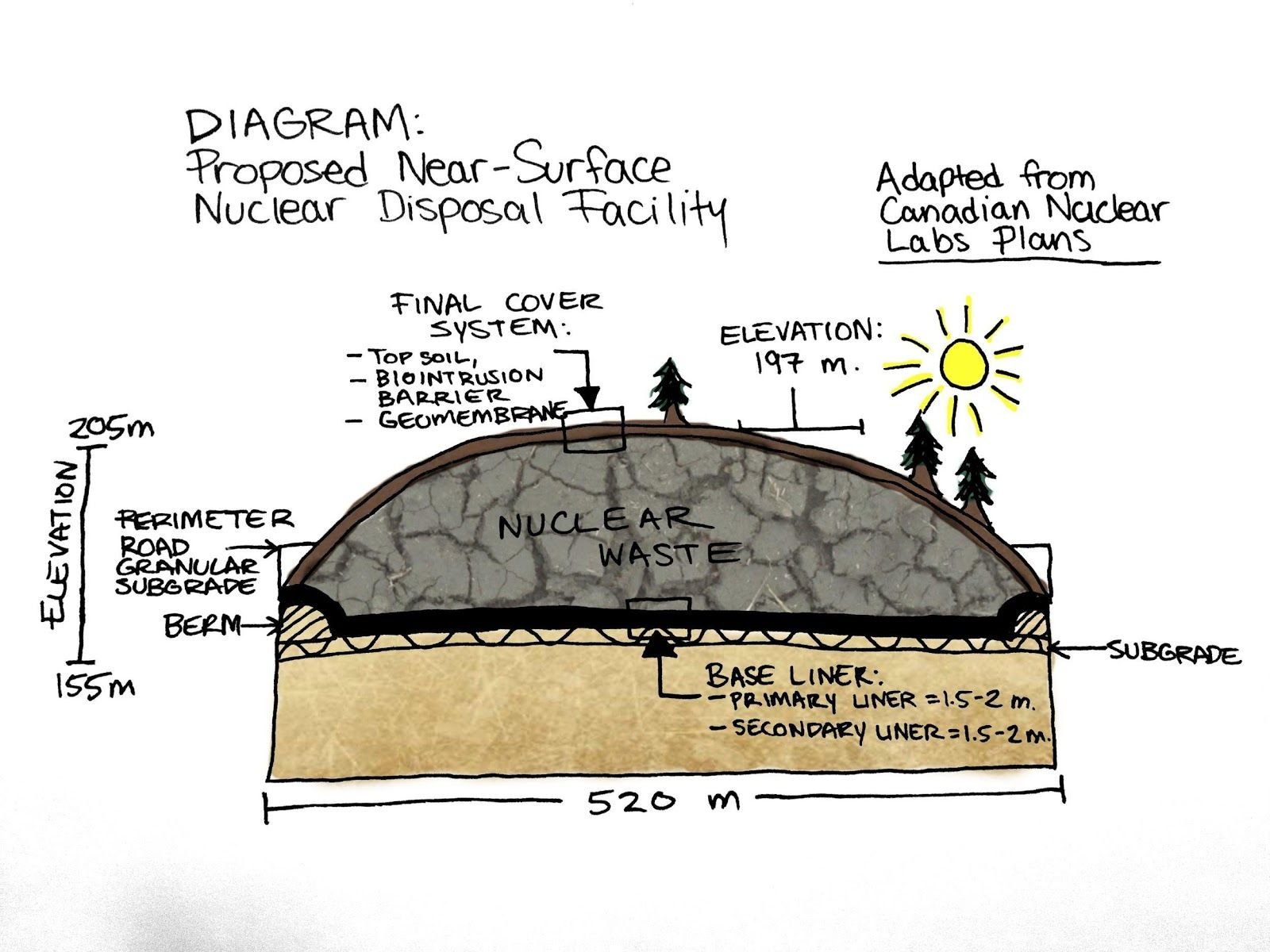
The proponent's plans for a Near Surface Disposal Facility are the first of its kind to be seriously considered in Canada. Graphic by Paloma Callo
The timeline for the project is monumental. The mound will be filled with low-level nuclear waste that is currently held on site at Chalk River, as well as a small amount of waste that will be transported to the facility from other locations such as hospitals, universities and other nuclear facilities in Canada. Five per cent of the total waste will come from Whiteshell Laboratories in Manitoba, which is undergoing its own decommissioning process.
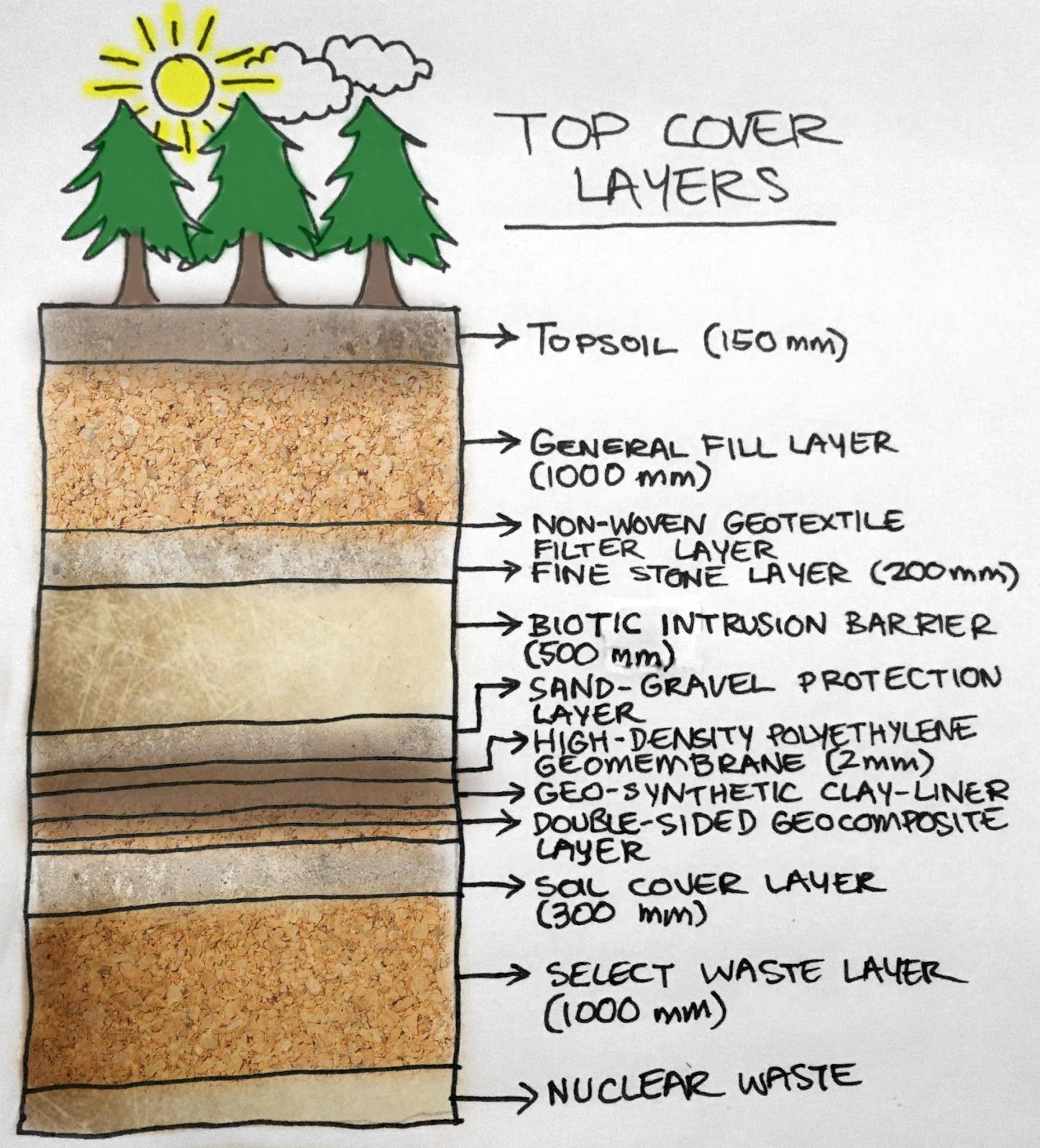
The waste in the mound would be split into cells according to contaminants or time for decay. A temporary cover would allow time to add radioactive waste for 50 years. When the site is full it would be permanently sealed.
The site would be monitored for 300 years after the permanent cover is installed at which point the radioactive material will have decayed. The facility is designed to last 550 years, the company says.
The radioactive waste inside the mound will break down. The half-life for tritium is around 12 years, and the half-life for strontium-90 is about 29 years. That means half of the tritium or strontium stored on the site decays during that period, with half of the remainder taking a further 12 or 29 years to decay. The process keeps repeating itself until ultimately all the material has broken down.
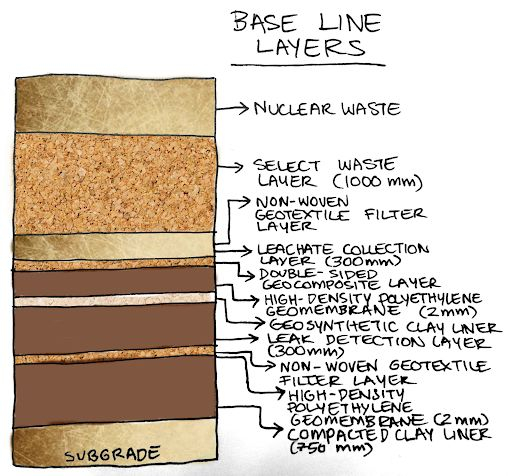
The engineered containment mound is CNL’s preferred nuclear waste storage option. In its draft environmental impact statement, CNL includes a discussion of the various other types of disposal options and techniques including deep-underground repositories, above-ground cement vaults and different on-and off-site locations.
In an opinion article in the Ottawa Citizen in April 2018, Eva Schacherl, a former executive director of the Canadian Environmental Network, argued the project was “the wrong plan at the wrong site,” and a vault buried hundreds of metres deep below the grounds should have been chosen.
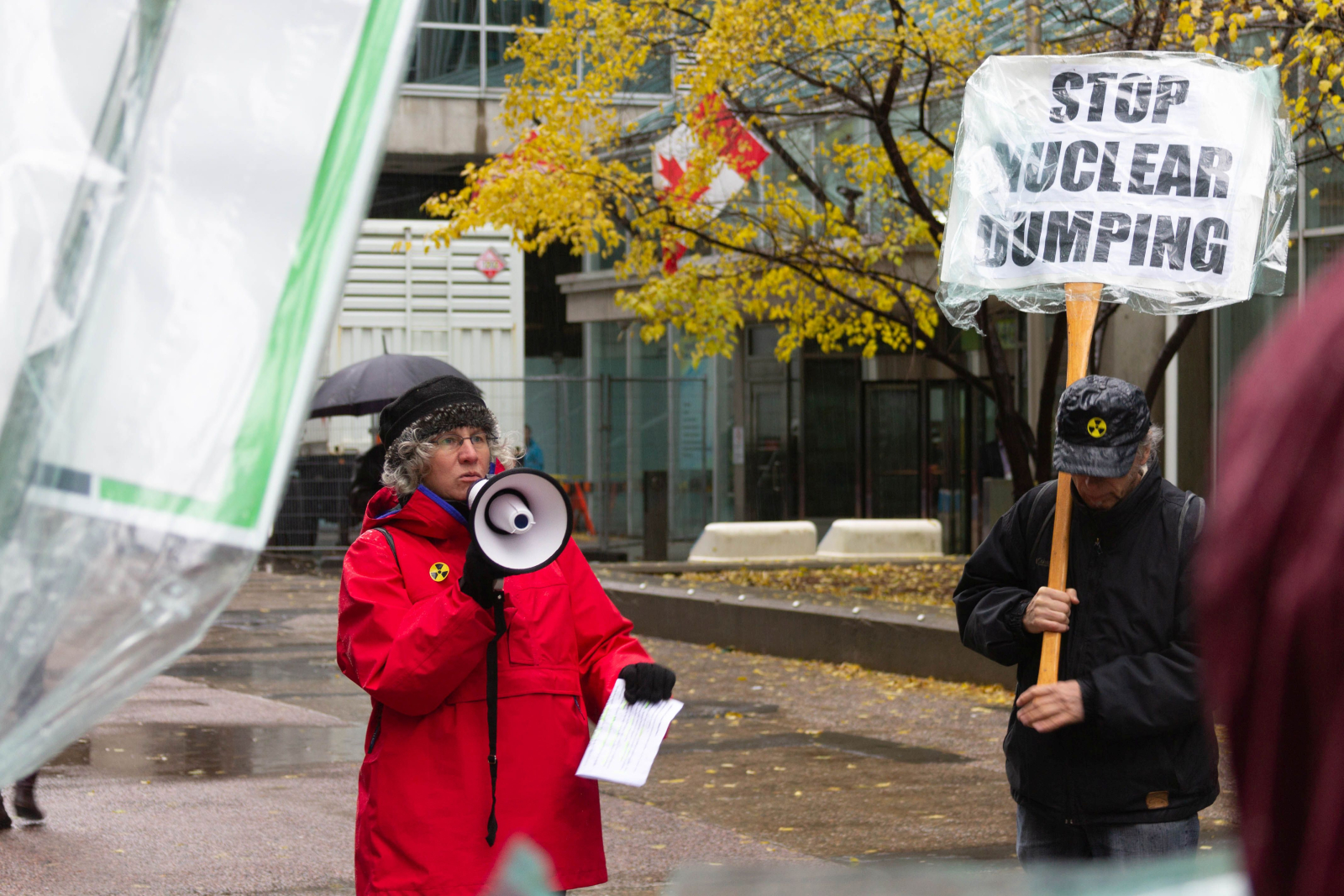
In a draft environmental assessment, the lab did not conduct geological tests far below the surface. Although the deep-underground method provides additional protections against leakage, CNL says there is not enough evidence to outweigh the benefits of its chosen model.
A deep-underground vault would be much more expensive to monitor and maintain over its life cycle, according to CNL’s analysis. CNL has made several changes to the proposal since public consultations began in May 2016, in response to some of the hundreds of initial comments by the public during an ongoing environmental assessment.
Ottawa Riverkeeper advocates a type of facility that does not come into contact with water. "We want a solution that will safeguard all species from the radioactive waste that is currently onsite at Chalk River and Rolphton,” Riverkeeper said in a Nov. 1 update. “We would like to see Canada look to countries like Finland who have constructed siloed geological repositories to safeguard all levels of radioactive waste. We want a disposal facility where radioactive waste does not come into contact with water."
CNL acknowledged during an interview for this story that it was not transparent enough during the environmental impact statement process in explaining why the particular location near the Ottawa River on the CRL site was the best choice.
Subsequent studies, analyses and updates to the document are part of the delay that will push the delivery of CNL’s final environmental impact statement to the CNSC for approval back to around spring 2020, according to the company. The delay was also caused by technical questions from provincial and government agencies that have required additional study, including a notable point where nuclear waste is discharged into Perch Lake.
The public comment process has led to other significant changes to the project design. The original project was meant to hold predominantly low-level intermediate waste, but also allowed for about one per cent intermediate-level waste or mixed wastes. The company has now decided to restrict the waste going into the storage facility to only the low-level category.
The change was purely driven by feedback from the community, the company representatives said. The site was never intended to hold high-level waste, such as spent nuclear fuel from a reactor.
“It’s in response to concerns from the public or interest groups,” said Meggan Vickerd, director of the nuclear waste facility project for CNL. “Intermediate-level waste was only a fraction of the inventory, plus it was not all of the intermediate-level waste, so we knew we still needed another facility.”
Controversy over near-surface disposal
The company says the project prompted hundreds of public comments during its opening consultation phase. Pat Quinn, CNL’s communications director, says the company is dedicated to transparency and open communication.
Activist organizations and Indigenous groups have raised a number of red flags about the suggested nuclear waste site and the overall security of decommissioning, including its construction about one kilometre away from the river.
Riverkeeper has also emphasized that despite the Canadian government’s rhetoric about the importance of a Nation to Nation relationship, “there has been no consultation with Indigenous Governments to develop a radioactive waste policy on terms that would be acceptable to Indigenous peoples.
“Likewise, there has been no consultation with the Algonquin Anishinaabe people about consolidating all federal radioactive wastes within their traditional, unsurrendered territory.”
Some local farmers have also expressed concern. One is Taylor Hanrath, an organic pork farmer and the owner of Butternutty Farm who lives downstream in Pembroke.
“If there’s a leak at all, in some way, shape, or form it would have the pretty big Ottawa River right beside it to transport it quickly and there’s always going to be the potential for human error, on top of a possible earthquake or tornado.” Hanrath said. “Even right now I don’t know what the plan would be for my farm if a leak were to happen at the current site.”
Ian Clark is a professor of environmental science at the University of Ottawa who has worked with AECL to find rock deep enough to drill a cavern suitable for disposing nuclear waste in secure, isolated places for at least the lifetime of radioactive decay.
“You don’t need up to a million or years or so that you might want to have for high level waste,” Clark says. Tritium and strontium have relatively short half-lives and other isotopes stay radioactive for much longer. Given the high costs just to prospect for deep disposal options, the scientist says, it is likely “too much effort or overkill for low level waste.”
The International Atomic Energy Agency safety guidelines for near-surface disposal include building features that are “aimed at the isolation of radioactive waste from people and from the accessible biosphere.” The guidelines say the site should be located away from known areas of underground mineral, geothermal, and groundwater resources that might damage it.
The Agency indicates better ways to store nuclear waste are to bury it in “caverns, vaults, or silos, at least a few tens of metres below ground level, and up to a few hundred metres below ground level.” It does state, however, that a near-surface facility would be sufficient for low-level waste, such as decommissioned structures, old laboratory materials and soil.
Another issue is how extreme weather events may affect the storage facility during construction, the 50-year operation period, and in the hundreds of years after its closure.
Following the devastation from tornadoes in and around Ottawa in late September 2018, the Concerned Citizens and 86 other groups including First Nations and citizens groups from across Canada signed a collective call for an inquiry into how the Canadian government handles its radioactive waste.
Wait and see?
CNL devotes an extensive section to extreme weather preparedness in its nearly 1,000-page environmental impact statement. The project is designed to maintain wastewater treatment flow in the worst-case scenario of two back-to-back 100-year rainfall events. The lab says it believes the design will do well enough to avoid overflows and leaks of contaminated water or erosion of the engineered containment mound.
CNL acknowledges that tornados could damage buildings and other infrastructure, including the nuclear waste storage mound. The project design estimates a minute chance of a tornado strike. It says tornado protocols are already built into their emergency preparedness plan.
During the construction phase, CNL says, high winds could increase the amount of dust kicked up. The biggest concerns were tied to high winds during waste transfers and when the cells were covered with the temporary covers.
The environmental assessment considers climate change could contribute to the increased frequency of violent storms or tornadoes. That needs to be factored in to the project design, CNL says.
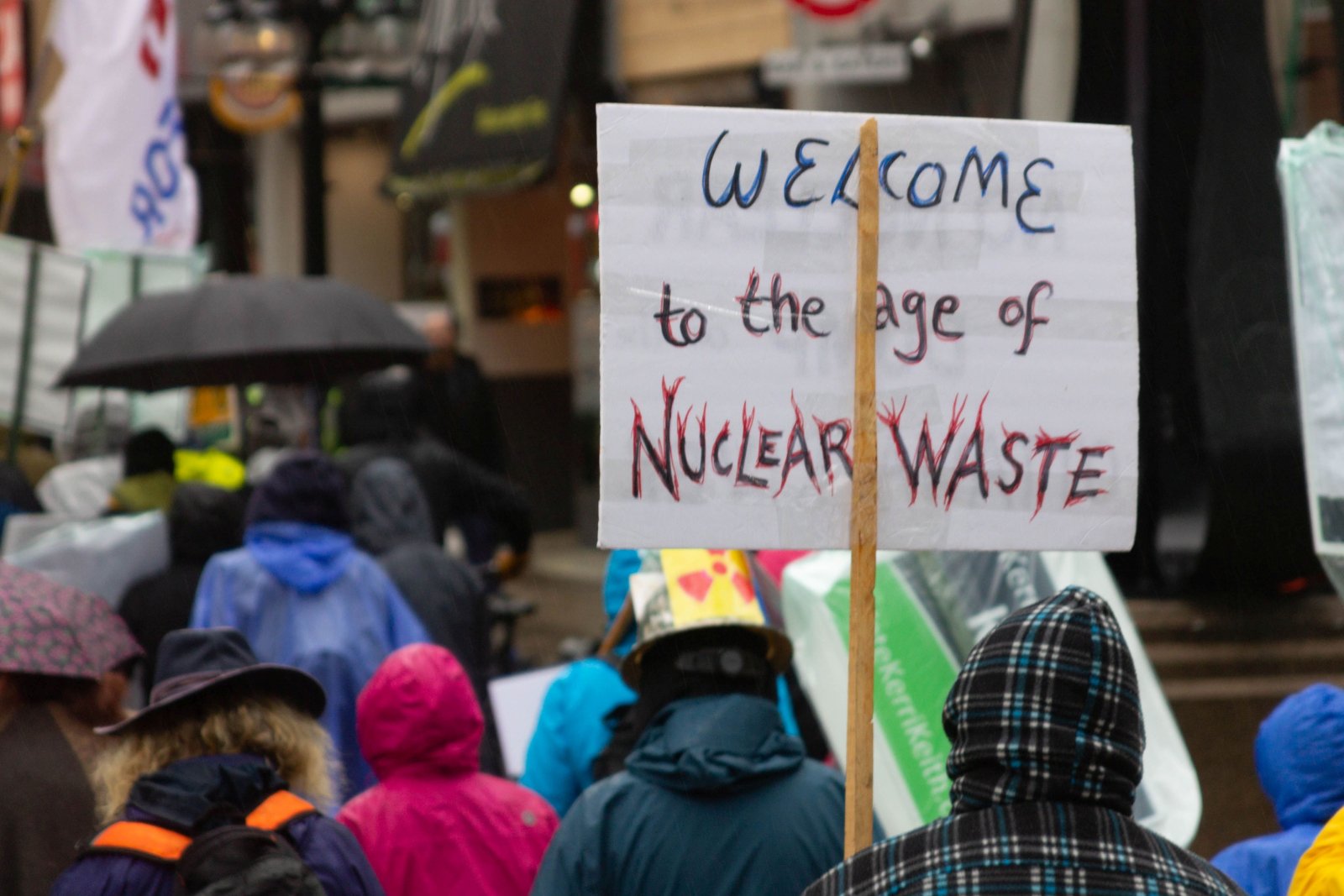
The lab maintains there is a low risk from low-level waste.
However, some 60,000 tons of dangerous radioactive waste from spent nuclear fuel reported on the shores of the Great Lakes at the Bruce, Pickering and Darlington nuclear generating stations is an unfriendly reminder that Canada has yet to figure out how to deal with its medium- and high-level radioactive junk.
Ian Clark, the former nuclear scientist, is convinced there is no overall risk to drinking water.
“All of this waste is not all of a sudden going to leak into the Ottawa River and poison everybody downstream,” Clark said.
“I imagine the greatest risk will be to the squirrels and bears who live in that little plot of land that they want to tear up.”
CNL's environmental impact assessment is expected to be ready for review this spring, three years after the Canadian Nuclear Safety Commission launched the environmental assessment process. Public hearings are to follow.
A final environmental assessment report must then be completed. CNL will then submit its license application to the Canadian Nuclear Safety Commission, followed by public hearings. The commission will likely issue its final decison in 2020 or 2021.
Editor's note: This article was produced by the Carleton University School of Journalism and Communication, in collaboration with the Institute for Investigative Journalism, Concordia University.
As I understand it, The
As I understand it, The Ottawa river runs along a geological fault line and while it is not very active the potential is there for an earthquake that might be strong enough to disrupt any protective measures.
Nuclear waste is such a universal and unsolved problem globally that it has almost killed the expansion of nuclear energy as a concept for replacing fossil fuel energy production. The liabilities involved rival those of the Tar Sands. Oddly, the various agencies working on these problems seem unable to find disposal sites that are immune to the tectonic actions of the earth's crust. And the recent disaster in Japan should raise concerns about geological events.









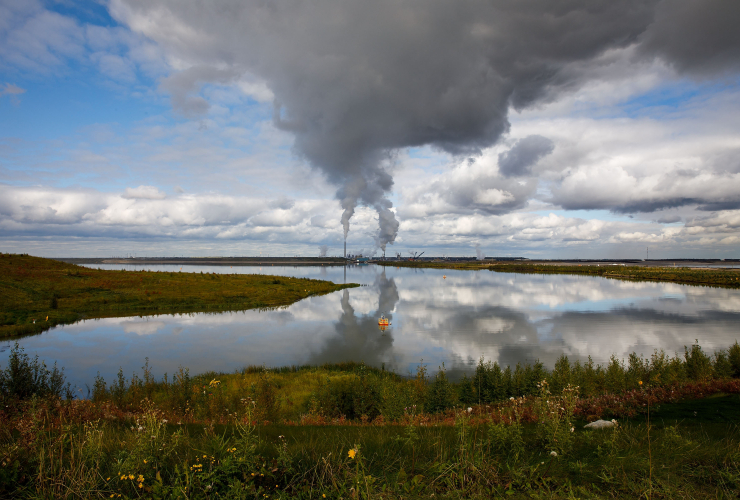
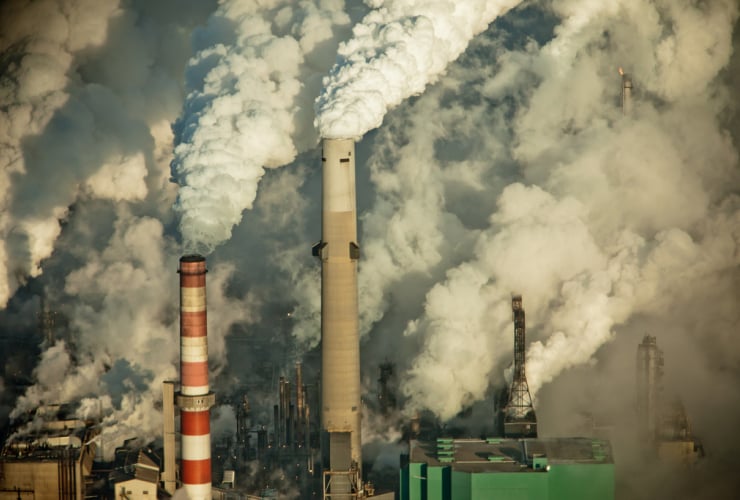
Comments